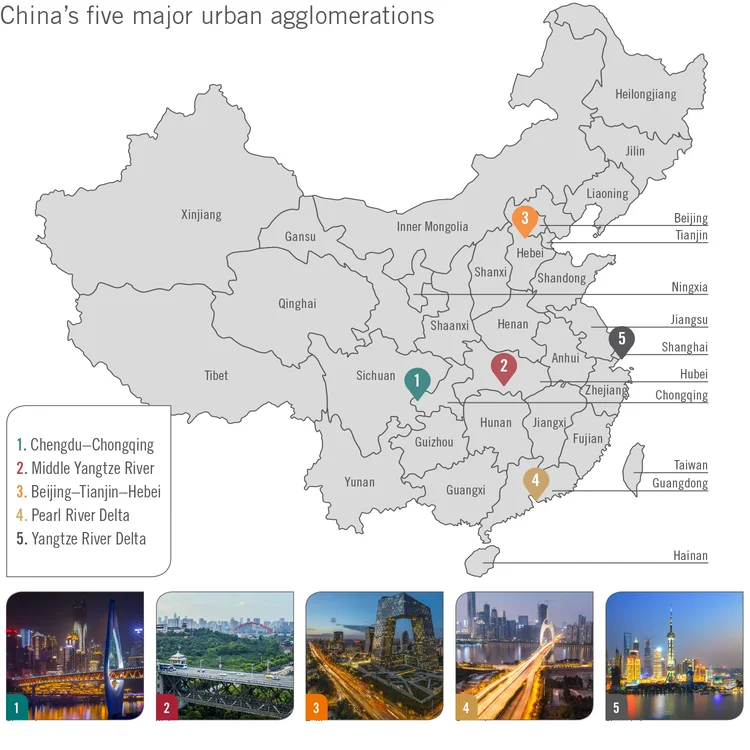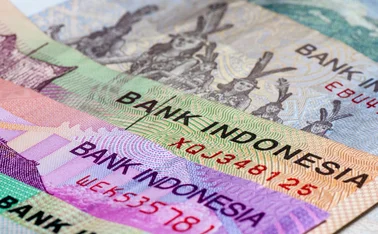
The cities that never sleep


After 40 years of reform and the policy of ‘opening-up’, China is no longer a planned economy. The Guangdong–Hong Kong–Macao Greater Bay Area is an important part of China’s urbanisation strategy 2.0, the National New Urbanization Plan.1 China’s ageing population is expanding rapidly, and capital and labour inputs to the economy are gradually declining. The national supply-side structural reform programme has five priority tasks – corporate deleveraging, cutting excessive industrial capacity, destocking property inventory, lowering corporate costs and improving weak links – but the key objective is to further promote urbanisation. Not, however, by relying on a few relatively developed megalopolises, but looking towards urban agglomerations.
New growth in satellite cities
Spillover is a prominent feature of urban agglomerations, which connect satellite cities with central cities and, as a result, a unified labour market and a complete industrial chain emerge. It becomes more convenient for people to meet and communicate, which produces a spillover effect in knowledge.

The inflection point was in 2010, when China’s high-speed railway began to roll out at scale in the Yangtze River Delta (YRD). Now, a journey between Wuxi and Shanghai can take as little as 30 minutes. Previously, economic development had been driven by the megacities, such as Shanghai and Hangzhou, but today the pace is set by satellite cities, with more rapidly transforming economies and smaller income gaps compared with Shanghai. The transportation infrastructure in the Greater Bay Area is lagging behind the YRD, although headway was made in late 2018. There will be around 10 intercity railways in operation by 2025, including the Shenzhen–Zhongshan Bridge, an enhancement of connectivity that will greatly boost productivity. Five major urban agglomerations in China – Beijing–Tianjin–Hebei, the YRD, the Pearl River Delta, the Middle Yangtze River and Chengdu–Chongqing – can be compared with other internationally successful urban agglomerations, such as the bay areas of New York, San Francisco and Tokyo. But China’s five major urban agglomerations have three advantages over the others that can be further exploited:
1. Large population base and high density. At present, Tokyo is considered the largest urban agglomeration in the world, but the average number of population per agglomeration in China is 110 million – almost twice that of the Tokyo capital economic circle. The advantage of a large population is it can absorb more industrial chains and more working and industrial modes. As trade friction between China and the US continues, some are concerned production chains will be removed from China, but it would be difficult to move if other places do not have the large population base and density to sustain factory transfers. Many European multinationals and investors often wonder why China’s internet and sharing economies – such as food delivery and car/bicycle sharing – are booming. It’s a matter of population. Take, for example, the UK: no city other than London can grow its sharing economy. The UK’s second-largest city, Birmingham, has a population of only 1 million, while the Greater Bay Area has seven satellite cities, with populations ranging from 2.5 million to 3 million. Population is the cradle of this economic pattern.
2. High efficiency in transportation. China has the world’s largest and most complete high-speed rail network. Since the opening of the Guangzhou–Shenzhen–Hong Kong high-speed railway, it takes only 47 minutes to travel from Hong Kong to Guangzhou South station, the equivalent of travelling between Los Angeles and San Diego. From the central business district (CBD) of Hong Kong to that of Shenzhen, it takes less than 30 minutes. In the world’s bay area cities, it is rare for two adjacent cities with such large populations to facilitate travel from one CBD to another in this time. With further development and roll-out of the 5G network, there will be improved face-recognition technology, which will also cut queues for security clearance and allow more rapid travel.
3. Flexible policies. China has introduced many policies to actively assist urban agglomeration development, such as differentiated household registration and employment and social security policies. The nation will further open up the household registration system, public resources, medical care, education and other supportive facilities for small and medium-sized cities. The population of Beijing has seen negative growth, while that of Shanghai has stagnated. The average annual growth rate of surrounding third- and fourth-tier satellite cities is more than 1.5%.
Flexible policy can drive the further rise of total factor productivity. The Greater Bay Area has a more advanced and co-ordinated industrial chain than its rivals – Guangzhou, Dongguan, Foshan and Shunde are leaders in high-end manufacturing; Shenzhen is the world’s foremost IT innovation city; Hong Kong and Shenzhen have a cutting-edge financial industry; and Zhuhai and Macao have long-established entertainment industries. The Greater Bay Area industrial chain aggregation and co-operation is unique; what is more, it is the centre of world-class shipping.
The synergy of capital markets in the Greater Bay Area is taking shape. Hong Kong is open to start-ups, technology and biotechnology companies. Two-thirds of China’s patent applications come from Guangdong, and many private companies apply for patents and innovate on their own. Hong Kong gives full rein to its legal system and arbitration and professional services. This strengthens the intellectual property rights and patents of foreign and private enterprises, which attracts more foreign investment and further protects private enterprises taking the initiative to innovate.
The Greater Bay Area has great potential, but it needs further reform; currently it resorts too often to Hong Kong’s innovative advantages to expand its opening-up. In view of local strengths and potential further reform and opening-up, it is estimated that, by 2030, the population of the Greater Bay Area will reach 88 million and its GDP will increase by nearly US$4 trillion. That would make it the fifth largest economy in the world, surpassing the UK, with a GDP of approximately $45,000 per capita. These estimations are based on the current advantages of the Greater Bay Area and the National New Urbanization Plan, as well as Guangdong’s intentions to further create a showcase of reform and opening-up.

Only users who have a paid subscription or are part of a corporate subscription are able to print or copy content.
To access these options, along with all other subscription benefits, please contact info@centralbanking.com or view our subscription options here: http://subscriptions.centralbanking.com/subscribe
You are currently unable to print this content. Please contact info@centralbanking.com to find out more.
You are currently unable to copy this content. Please contact info@centralbanking.com to find out more.
Copyright Infopro Digital Limited. All rights reserved.
As outlined in our terms and conditions, https://www.infopro-digital.com/terms-and-conditions/subscriptions/ (point 2.4), printing is limited to a single copy.
If you would like to purchase additional rights please email info@centralbanking.com
Copyright Infopro Digital Limited. All rights reserved.
You may share this content using our article tools. As outlined in our terms and conditions, https://www.infopro-digital.com/terms-and-conditions/subscriptions/ (clause 2.4), an Authorised User may only make one copy of the materials for their own personal use. You must also comply with the restrictions in clause 2.5.
If you would like to purchase additional rights please email info@centralbanking.com







